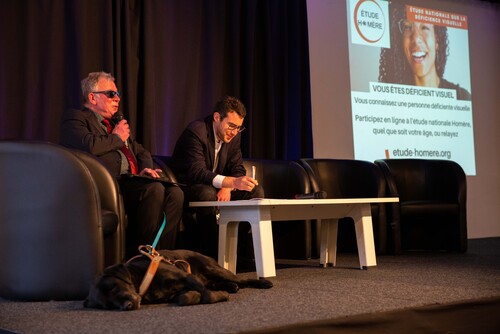Use the drop-down summary to access the articles in the folder.
Terms of republication
You can republish this article for free on your website, blog, etc.
Behind the scenes of research
To understand more about visually impaired people, so that their needs can be met more effectively: that was the aim of all those involved in the Homère study. Today, it is clear that the study’s strength lies in the number and diversity of the players involved, combined with its scientific rigour. It was based on a carefully co-constructed questionnaire, with responses received from people whose backgrounds and daily lives are as different as they are representative. This allowed the study to establish extremely valuable conclusions founded on data.
An innovative participatory approach
At the start of the project in 2020, the associations came together and defined a set of specifications to choose the study provider. In the end, a research consortium was chosen, for its desire to include the people concerned in the study and make the results accessible. "It was important for us to start with the individuals concerned and the impact of their visual impairment on their daily lives," says Mireille Prestini, former Director General of the Fédération des Aveugles et Amblyopes de France (FAAF). "In France, these worlds are separated, and too often we do things 'for' people and not enough 'with' them.”
Collaborative work, from data acquisition to analysis
The strength and originality of the Homère study lies in its national dimension and the way in which it was co-constructed with associations. They were involved in drafting and distributing the questionnaire and were invited to give their opinions of the various stages as the study advanced, at co-steering meetings. From creating the questionnaire to analysing the data, the associations worked in close collaboration with the researchers, in order to determine the most relevant results together.
More than 2,200 visually impaired people consulted
50 people (visually impaired people, their friends and family, professionals and researchers) took part in the various stages of creating the questionnaire, including discussion groups. Together, they drew up a list of almost 800 questions relating to mobility, access to employment, education, rights, digital technology etc. In the second phase, the number of questions was reduced to 191, resulting in the final questionnaire, which was submitted to blind and partially sighted people from all over France. Lastly, another series of workshops were held with the associations to prepare for analysing the data, identify the most interesting ways to cross-reference it and produce the final 250-page report.

![[Translate to English:] Licence creative commons BY-SA 4.0 [Translate to English:] Licence creative commons BY-SA 4.0](https://reflexscience.univ-gustave-eiffel.fr/fileadmin/ReflexScience/Accueil/Logos/CCbySA.png)